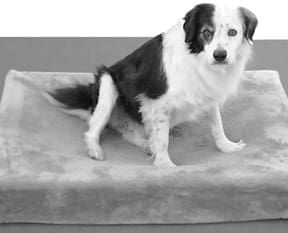The last time we reviewed dog beds was in the January 2000 issue. At that time, we were overwhelmed by the multitude of disparate models that are available: cot-style, foam, cedar-filled, fiber-filled, waterproof, waterbeds, circular, round (there’s a difference!), washable, impossible . . . it was kind of hard to know how to choose which ones to talk about.
This time, we decided to review just one category of bed: foam-filled. We chose this area of concentration for several reasons.
First, thick foam beds offer the most cushioning for your dog’s comfort – and a dog who is comfortable on his bed won’t continually sneak onto yours!
Second, in our opinion, after much exploration and experimentation, we have come to the conclusion that (good quality) foam beds hold up better than any other type over time. If you compare the life expectancy of a good foam bed with that of a good fiber-filled bed, for example, you’ll find the foam bed still in use long after its rival has gotten funky and been thrown out.
Not all foam beds can be thrown in a washing machine (we love the ones that can). But at least they can be taken outside and hosed off, which is a good thing to do occasionally, since immersion is an amazing anti-flea technique (see the article “Integrated Pest Management for Flea Control”). It’s a little difficult to wring them out – letting them drain by propping them up on one edge helps – but they air-dry surprisingly quickly. In contrast, many beds that are stuffed with cedar chips, fiberfill, or a combination of the two are almost impossible to wash.
Finally, we found so much variation in the quality of the products in this one category, we felt compelled to help you identify the beds that were truly worth the money and avoid the cheesy ones. And there are a lot of cheesy beds being sold.
Cheesiness may not be a huge concern for those commendable individuals who shop only in person; a one-minute, hands-on inspection of a bed is enough to prevent you from buying a product that is woefully inadequate. But many of our readers commonly buy products from online stores and print catalogs; all they have to go on is a scanty (and often inaccurate) description and a photograph. Believe us, the personal ads are more accurate than these portraits!
It’s funny; in the personal ads, people generally describe themselves as thinner than they really are. In ads for foam beds, sellers always describe their products as fatter than they really are! The foam is described as firm, thick, soft yet supporting, and cuddly; still more claims are made of “orthopedic foam,” also known as eggcrate or “cone and valley” foam. It’s frequently said to “distribute the dog’s weight” in some special but unspecified way and to “relieve pressure on joints.” A top-quality, dense eggcrate foam does provide variable pressure, which helps prevent loss of circulation, which is why hospitals use eggcrate foam mattresses on their beds. However, only a few of the “orthopedic” foam beds we examined utilize foam that is thick enough or dense enough to actually provide the sought-after effect. Most are so thin that they can easily be squashed between your thumb and forefinger to a blanket’s thickness.
Selection criteria
As you may have guessed, the density or thickness of the foam used in the beds we examined was our main criterion for choosing which beds to order. We selected beds that either looked especially thick or were described as especially thick. In a couple of cases, where the description made the bed sound luxuriously dense and the picture made the bed look thin, we ordered the product anyway, just so we could bust ’em on it.
On the following pages, we describe the products we tested, including beds we love and a bunch that we don’t want you to waste your money on. While the thickness of the foam, as we’ve hinted, was a major preoccupation, it wasn’t our only selection criteria. We also considered the following:
• Foam quality (not just thickness): Some of the foams used are very granular and feel like they will quickly disintegrate. The ones we like are more dense and durable.
• Cover quality: Some of the fabrics we examined appeared to be no more durable than a premium paper towel. Others were tough as all-get out, but not very cozy. We like something in the middle. You may have a reason to choose one or the other; we describe all the fabrics so you can choose.
• Ability to easily replace the cover after washing: This is a hard-and-fast rule: If a bed makes us weep in frustration or gnash even a single tooth, we don’t like it. In our house, a reputation of being difficult to launder means it won’t get laundered very often, and that’s not good. (Maybe you have someone who handles this sort of thing for you. We don’t.) To this end, we like zippers that are positioned on the long side of beds, or elastic that has enough latitude to allow for less than factory-perfect placement without folding the bed into a strange parabola that your dog feels differently about ever afterward – you know what we’re talking about, don’t you?
• Unique features: We note anything that increases the convenience or charm of one of the beds, such as free alternate covers, or the availability of a waterproof cover (for incontinent dogs).
• Attractiveness: We’re putting this last, because it’s not really very important. But we are including it, because these dang beds are laying all over all of our homes, and they might as well look good, right?
We’ll note prices, but don’t suggest using price as your main selection criterion. We found a couple of bargains (relative to the products’ quality), and we’ll note those. But some of the expensive beds are costly because they truly are so much better. Also, we ordered fairly large sizes in all of the beds, which cost a lot more than small sizes. In general, we suggest you get a bed that is bigger than your dog really needs; dogs tend to reject beds that are too small.
We used to include “Ability to be returned” in our list of criteria. We actually did return a number of beds this time, and didn’t have a problem receiving a refund for the purchase price from any of the sellers.
However, we were horrified to discover that the shipping for some of the beds – which are generally light but shipped in big boxes – ended up costing almost as much as the beds themselves! The sellers, we learned, receive commercial, bulk rates for shipping from all the major carriers. We have no such account, and it cost us big time. With our warnings about all of the beds that we don’t think are worth their cost, you shouldn’t have any reason to return one.
Note: Be advised that in the time since this article was originally published the company PC Panache has changed its phone number and the old one is not forwarding. The number listed in the chart is now incorrect. The new number is 610-689-3829.
-by Nancy Kerns







Keep in mind that smalldogelite.com do free shipping on all the beds have questions call or email….